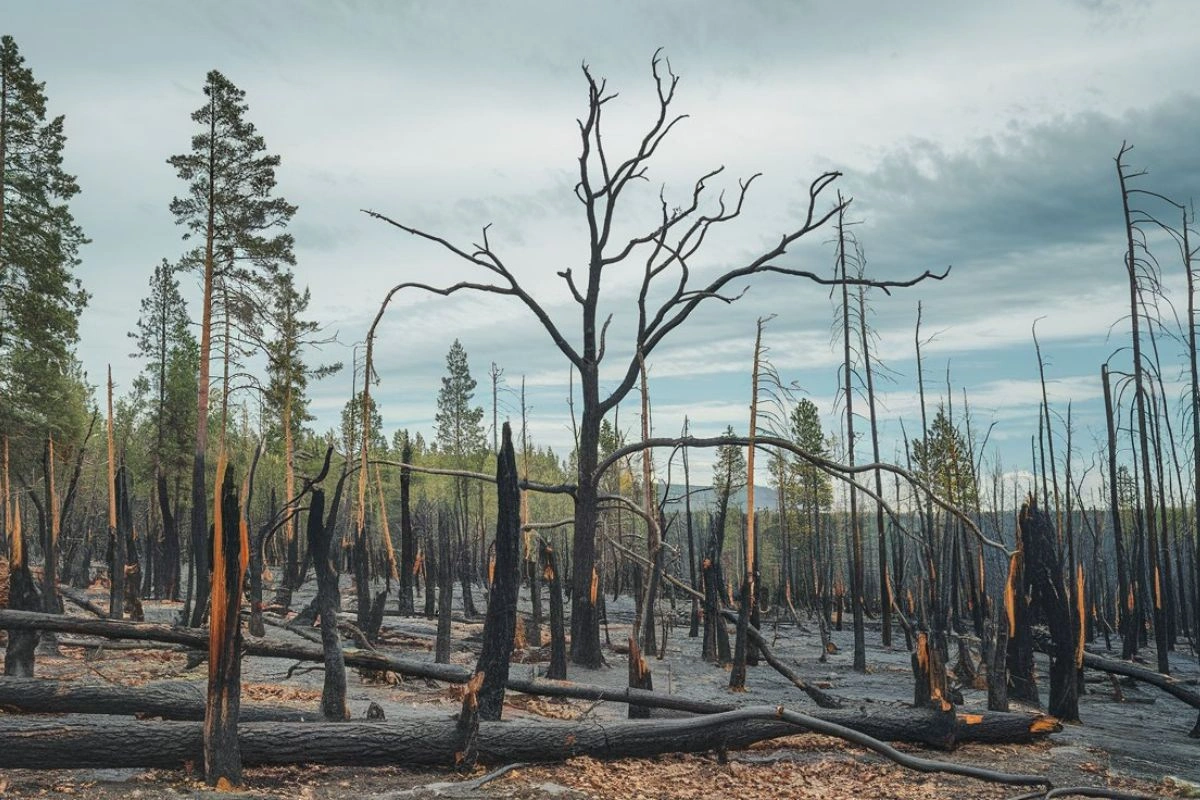Acid rain is a significant environmental issue caused by the deposition of acidic components in precipitation such as rain, snow, fog, or dust. This process occurs when sulfur dioxide (SO₂) and nitrogen oxides (NOₓ) enter the atmosphere and react with water molecules, oxygen, and other chemicals, leading to the creation of acidic compounds. These acidic pollutants fall back to Earth, damaging ecosystems, infrastructure, and human health. Acid rain is primarily linked to industrial activities, fossil fuel combustion, and vehicular emissions.
In this detailed article, we will explore acidic rain in depth, examining its causes, formation processes, environmental and economic impacts, and sustainable solutions to mitigate its effects.
1. Introduction to Acid Rain
Acid rain first came to scientific attention during the Industrial Revolution when coal combustion in factories and power plants began releasing large quantities of sulfur dioxide into the atmosphere. Over time, researchers noted its adverse effects on vegetation, aquatic ecosystems, and buildings. In the 20th century, acid rain gained global attention as one of the most visible consequences of air pollution.
Despite efforts to mitigate its effects, acidic rain remains a challenge in many parts of the world, especially in regions with heavy industrial activity and high fossil fuel consumption.
2. What is Acid Rain?
Definition
is precipitation that has a pH value below 5.6. The acidity arises from sulfuric and nitric acids formed in the atmosphere when sulfur dioxide (SO₂) and nitrogen oxides (NOₓ) react with water and oxygen.
pH Scale and Acidity of Precipitation
- Normal Rain: Naturally, rain is mildly acidic with a pH of approximately 5.6, caused by dissolved carbon dioxide forming weak carbonic acid.
- Acid Rain: Can have a pH as low as 4.0 or lower in severely polluted areas.
3. Formation of Acid Rain
The Impact of Sulfur Dioxide and Nitrogen Oxides
The main pollutants that cause acidic rain include:
- Sulfur Dioxide (SO₂): Emitted from burning fossil fuels, especially coal and oil.
- Nitrogen Oxides (NOₓ): Released from vehicles, power plants, and agricultural activities.
These acids mix with atmospheric moisture and precipitate as acid rain.
4. Primary Causes of Acid Rain
Natural Sources
- Volcanic Eruptions: Emit large amounts of sulfur dioxide.
- Wildfires: Release nitrogen oxides and other acidic compounds.
- Decaying Vegetation: Naturally releases small amounts of sulfur compounds.
Human Activities
- Industrial Emissions: Power plants and factories burning fossil fuels are major sources of SO₂ and NOₓ.
- Vehicular Emissions: Internal combustion engines produce nitrogen oxides.
- Agriculture: Fertilizer use contributes to nitrogen oxide emissions.
5. Types of Acid Rain
Wet Deposition:
- Acidic rain, snow, or fog falls to the ground, directly affecting soil, water bodies, and vegetation.
Dry Deposition:
- Acidic particles and gases settle on surfaces and mix with water to form acid when moisture is present.

6. Impacts of Acid Rain
Environmental Effects
- Aquatic Ecosystems: Acidification of lakes and rivers harms fish and aquatic life, disrupting food chains.
- Soil Degradation: Alters soil pH, leaches essential nutrients, and releases toxic metals like aluminum.
- Forest Damage: Weakens trees by stripping nutrients and damaging leaves, making them vulnerable to disease.
Damage to Infrastructure
- Corrosion: Acidic rain corrodes buildings, bridges, and monuments, especially those constructed from limestone and marble.
- Increased Maintenance Costs: Infrastructure in polluted regions requires frequent repairs.
Effects on Human Health
- Respiratory Problems: SO₂ and NOₓ exacerbate asthma, bronchitis, and other respiratory illnesses.
- Contaminated Drinking Water: Acidic rain leaches toxic metals into water supplies, posing health risks.
7. Areas Most Impacted
- Northeastern United States: High industrial activity and coal-burning power plants contribute .
- Europe: Germany, Poland, and the UK experience significant acidic rain due to industrial emissions.
- Asia: Rapid industrialization in China and India has led to severe acidic rain issues.
8. Acid Rain and Climate Change Relationship
The relationship between acidic rain and climate change is complex and interconnected. Acid rain is primarily caused by the emissions of sulfur dioxide and nitrogen oxides, which are generated from burning fossil fuels. These same activities contribute to climate change by increasing greenhouse gas emissions, particularly carbon dioxide.
As climate change progresses, it can influence precipitation patterns, potentially increasing the frequency and intensity of acid rain events in certain regions. Warmer temperatures may also exacerbate the chemical reactions that produce acid rain. Conversely, acid rain can affect ecosystems’ resilience to climate change, damaging forests and water bodies, which play crucial roles in carbon sequestration.
Addressing both issues through sustainable practices and emissions reduction is essential for mitigating their combined impacts on the environment.
9. Solutions to Acid Rain
Preventive Measures
Emission Reductions:
- Install scrubbers in industrial plants to capture SO₂.
- Promote the adoption of cleaner fuels and renewable energy sources.
Stricter Regulations: Enforce limits on industrial emissions and vehicle standards.
Mitigation Strategies
- Limestone Application: Adding limestone to acidic soils and lakes neutralizes acidity.
- Reforestation: Restores damaged ecosystems and absorbs air pollutants.
10. Innovative Technologies for Controlling Acid Rain
- Flue Gas Desulfurization: Eliminates sulfur dioxide from emissions produced by power plants..
- Selective Catalytic Reduction (SCR): Reduces nitrogen oxides in vehicle and industrial emissions.
- Emission Monitoring Systems: Enable real-time tracking of pollutants.
11. Global Policies and Treaties to Combat Acid Rain
- The Clean Air Act (USA): Implemented cap-and-trade programs for sulfur dioxide emissions.
- The Gothenburg Protocol (Europe): Seeks to decrease air pollutants that lead to acid rain.
- United Nations Agreements: Encourage international collaboration on air quality improvement.
12. Community and Individual Roles in Reducing Acid Rain
- Reducing Energy Consumption: Using energy-efficient appliances lowers demand on fossil fuel-based power plants.
- Promoting Public Transport: Reduces vehicular emissions.
- Tree Planting Campaigns: Helps absorb pollutants and restore ecosystems.
13. Case Studies of Acid Rain Control
United States
The Clean Air Act’s cap-and-trade system successfully reduced SO₂ emissions by over 50% between 1990 and 2010.
Europe
Strict emission standards and renewable energy initiatives have significantly reduced acid rain across the continent.
14. Challenges in Addressing Acid Rain
- Economic Costs: Transitioning to cleaner technologies can be expensive for industries.
- Global Coordination: Pollutants often cross borders, requiring international cooperation.
- Incomplete Adoption: Some countries lack stringent environmental regulations.
15. Future Outlook Management
The future outlook for acidic rain management focuses on reducing emissions of sulfur dioxide and nitrogen oxides through innovative technologies and regulatory frameworks. Continued advancements in renewable energy sources, such as wind and solar, will play a crucial role in decreasing reliance on fossil fuels.
Enhanced emission control technologies, like scrubbers and catalytic converters, will further mitigate pollutants from industrial sources and vehicles. International cooperation is essential, as pollutants can travel across borders; thus, global agreements will strengthen collective efforts.
Public awareness and education on the impacts of acidic rain will empower communities to advocate for cleaner practices. Ultimately, a combination of technological innovation, policy enforcement, and community engagement will be vital to effectively manage and reduce in the future.

16. frequently asked questions (FAQs) :
How can I tell if acidic rain is affecting my area?
You can monitor local environmental reports, which often include data on air quality and precipitation acidity. Signs of acid rain damage include stained or eroded buildings, dead fish in nearby water bodies, and poor plant health.
Is acid rain a global issue?
Yes, is a global concern. While its effects may be more pronounced in industrialized regions, the pollutants responsible for acid rain can travel long distances in the atmosphere, affecting areas far from their source.
What are the primary causes of acid rain?
The main causes are emissions from industrial processes, power plants, and vehicles that burn fossil fuels. These activities release sulfur dioxide and nitrogen oxides into the atmosphere, which then contribute to the formation of acid rain.
How does acid rain affect the environment?
Acid rain can harm aquatic ecosystems by lowering the pH of water bodies, which affects fish and other aquatic life. It also damages soil, forests, and crops by leaching essential nutrients and weakening plant health.
What can be done to reduce acid rain?
To reduce acid rain, efforts should focus on decreasing emissions of sulfur dioxide and nitrogen oxides. This can be achieved through cleaner energy sources, improved fuel standards, and the implementation of regulations such as cap-and-trade programs. Public awareness and advocacy for sustainable practices are also crucial in addressing this issue.
Conclusion
In conclusion, addressing acidic rain and its relationship with climate change is essential for protecting ecosystems, human health, and infrastructure. The interplay between acid rain and climate change highlights the need for integrated strategies that reduce emissions of sulfur dioxide and nitrogen oxides while also tackling greenhouse gas emissions.
Sustainable practices, technological innovations, and robust regulatory frameworks are crucial for mitigating these environmental challenges. Public awareness and community engagement play significant roles in fostering responsible behaviors and supporting policy initiatives. By prioritizing actions that address both acidic rain and climate change, we can create a healthier environment and ensure the resilience of our natural resources for future generations. Collective efforts will be key to achieving long-term sustainability and environmental protection.

